They say… 
Best beer and travel writing award 2015, 2011 -- British Guild of Beer Writers Awards
Accredited Beer Sommelier
Writer of "Probably the best book about beer in London" - Londonist
"A necessity if you're a beer geek travelling to London town" - Beer Advocate
"A joy to read" - Roger Protz
"Very authoritative" - Tim Webb.
"One of the top beer writers in the UK" - Mark Dredge.
"A beer guru" - Popbitch.

|
Beer sellers: De Bierkoning
ABV: 5%
Origin: ’s-Gravenpolder, Zeeland, Netherlands (now at Meer, Antwerpen, Vlaanderen)
Website: www.scheldebrouwerij.nl
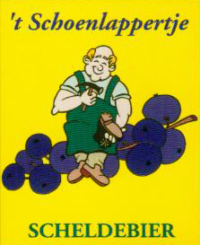 Scheldebrouwerij 't Schoenlappertje Scheldebrouwerij is that rare thing, a microbrewery that moved countries. Founded by home brewers Kees van Loenhout and Peter van der Eijnden in 1994, it was originally in Zeeuwse-Vlaanderen, a detached southern exclave of the Dutch province of Zeeland with Belgium to the south and the Schelde estuary to the north, thus the name. Establishing a good reputation for inventive and consistent beers, it was in need of more space by 2008, and the most convenient option turned out to be over the border at Meer in Belgium, in the former premises of the old established but now defunct Sterkens brewery. The fact that the bottles could now carry the legend ‘Belgisch bier’ was another bonus given the cachet of Belgian brewing in the Dutch market.
My notes on Schoenlappertje are based on a Dutch-brewed version from before the move. It’s brewed with blackcurrant juice and natural blackcurrant flavour, pale and caramalts, candy sugar and hops. The blackcurrants are sourced from Zuid-Beveland on the north bank of the Schelde, where 75% of Dutch production of the fruit originates, and where the old dialect term for these tart little gems is ‘schoenlappertje’ – ‘little cobbler’.
The blackcurrants have given this bottle conditioned beer a ruby red colour with a lowish white head and a Ribena-tinged candied aroma with a light malty note. The palate is rounded with sweetish toffee malt well balanced with blackcurrant tartness and a well-judged note of hops. On the swallow the blackcurrant flavours are reminiscent of Cabernet Sauvignon wine, and there’s a long finish with a splash of herby hops and minty toffee. Boasting a genuine local connection to the brewery’s origin, this is a contemporary fruit beer worth trying.
Read more about this beer at ratebeer.com: http://www.ratebeer.com/beer/scheldebrouwerij-t-schoenlappertje/6936/1/2/
Beer sellers: De Bierkoning
ABV: 5.8%
Origin: Bodegraven, Zuid-Holland, Netherlands
Website: www.brouwerijdemolen.nl
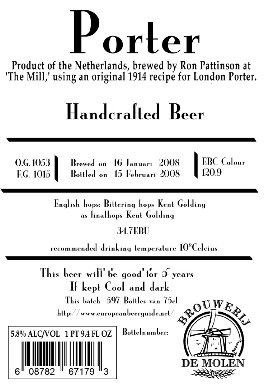 De Molen 1914 Porter Another of the impressive range of porters and stouts to have emerged from under the “ark dove” windmill in Bodegraven, this limited edition beer was produced in 2008 by brewer Menno Olivier and beer historian Ron Pattinson, based on a Whitbread recipe from 1914 – the last year of the glory days of stout and porter brewing in London before World War I drove down gravities and left the style terminally pigeonholed as an old man’s drink.
Brewed with pale, brown and black malts and sugar and hopped with East Kent Goldings, the beer is very dark brown with an amber tinge and a lowish fawn head. A smooth, quite light chocolate, fruit and roast aroma heralds a full malty chocolate milk palate, a little thin and gently tangy with smoke, biscuits and fleeting herbs. A gently roasty finish has sappy fruit and more chocolate. Overall a well-made beer with a straightforwardness that strengthens its claim to authenticity.
Ron’s joy at the opportunity to recreate this beer and its stronger sister SSS Triple Stout should inform your joy in drinking them, if you can still track them down. See his blog post at http://barclayperkins.blogspot.com/2008/01/joy-unbound.html.
Read more about this beer at ratebeer.com: http://www.ratebeer.com/beer/de-molen-1914-porter/84684/
Beer sellers: De Bierkoning
ABV: 7%
Origin: Amsterdam, Noord-Holland, Netherlands
Website: www.brouwerijhetij.nl
 't IJ Speciale Vlo Amsterdams Biobier From one of the Netherlands’ best established and most consistently good micros, this is a decidedly local beer, commissioned from ’t IJ on Amsterdam’s Funenkade by the Bierkoning beer shop by the Dam, not more than two kilometres away. The name Vlo means ‘flea’ but also apparently stands for ‘Vodden, Lompen, Ongeregeld’ – ‘Rags, more rags, irregular.’ That last word describes its availability on draught at the brewery’s tasting room, but it’s always on sale bottle conditioned at the shop. These days all the ingredients are organic, including judiciously deployed coriander.
There’s nothing raggy or fleabitten about this rich amber, heavily sedimented beer with its creamy off-white head. A sweetish, yeasty and orangey aroma has notes of coriander and toffee, while the smooth brown sugar palate is soon dried by a complex mix of hops and medicinal herbs. Following a smooth swallow there are more hops and bitter herbs over barley sugar and spiced orange in the finish. A big and vivid beer that’s perhaps worth ageing a couple of months to round off its raw edges.
Read more about this beer at ratebeer.com: http://www.ratebeer.com/beer/t-ij-speciale-vlo/6060/
First published in Beers of the World August 2008
 Meadow Farm Shop, Tyndyrn No longer a land of keg-only pubs closed on Sundays, Wales is currently one of Britain’s most dynamic brewing regions. The nation’s cultural independence and distinctiveness has been boosted further by devolution, including a renewed pride in its beer – whether from old-established independents celebrating their traditions, or the innovative new crop of small breweries springing from the hills and valleys of the mountainous principality. And many of them are finding that bottling plays an increasingly important role in the business plan, as craft-brewed beer complements other local produce in village shops and on market stalls for the pleasure and interest of visitors and residents alike.
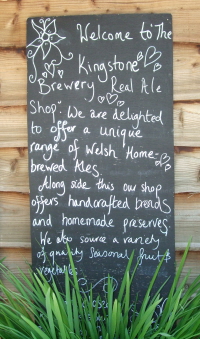 Meadow Farm Shop blackboard A good time, then, for someone to specialise in selling Welsh bottled beer, which is just what Edward Biggs and his wife Tori thought when considering options for expanding their Monmouthshire farm shop. They’d given up earning a living renovating property and opened Meadow Farm Shop as an outlet for their organic fruit and veg and homemade produce in 2004. Last summer they added The Welsh Beer Shop, and soon afterwards heard one of their suppliers, Kingstone Brewery in nearby Whitebrook, was to close. Edward, a former home brewer, seized the opportunity to buy the name, recipes and plant, which is now back in action at Meadow Farm.
Around a dozen other brewers from all over Wales are featured besides the extensive Kingstone range: Breconshire and Ffos y Ffin are best sellers but they also stock the rare and delightful Jolly Brewers beers, Otley’s stylish products, Conwy, Cwmbran and several others, mainly Real Ale in a Bottle. Beers can be enjoyed at the café and beer garden and there are occasional tastings.
Shop and brewery occupy an idyllic setting in an Area of Outstanding Natural Beauty, halfway up the richly wooded western slope of the Wye valley, just off the A466 north of Tintern and almost literally a stone’s throw from England. A two-hourly bus between Chepstow and Monmouth stops at the bottom of the drive. The Wye Valley Walk passes close by, running through the gorgeous riverside Old Station countryside site to Tintern village with its haunting ruined abbey. Offa’s Dyke Path traces the dramatic hillside of the English bank of the Wye opposite. I visit on a fine June day when the mouthwatering smell of a fired-up mash tun mingles with the scent of wild garlic from the woods. “It’s lovely working in a place like this,” sighs brewery worker Mark Gardner with feeling.
 Inside Meadow Farm Shop “More and more people are turning to real ale, which has helped the growth of small producers,” says Edward. “We now have such diversity and the quality is fantastic, though some are a challenge to track down – I go straight to brewers themselves but even then it’s hard to get hold of some that are produced in very small quantities. We’re helping set up the Association of Welsh Independent Brewers to help with the overall promotion and distribution of Welsh ales, so there are exciting times ahead.”
Fact file
Address: Meadow Farm, Tintern, Chepstow NP16 7NX
Phone: +44 (0)1291 680111
Web: www.kingstonebrewery.co.uk
Hours: Mon-Wed, Fri-Sat 0900-1600
Drink in? Yes
Mail order: Only Kingstone’s own beers
Manager’s favourites: Kingstone Classic, Humpty’s Fuddle; Jolly Brewer Cwrw Du
Beer picks
- Breconshire Red Dragon 4.7%, Aberhonddu, Powys. Distinctive and unusual cherry red beer that nods to Tyneside browns and Irish reds: nutty, twiggy, dry and finally spicy.
- Conwy Cwrw Castell 3.8%, Conwy. Refreshing amber bitter with a Cascade hop flourish and spicy ginger and blackcurrant and rounded bitterness over classic biscuity malt.
- Jolly Brewer Taid’s Garden 4.3%, Wrecsam. One of several delightful beers from tiny brewery linked to homebrew supplies shop: pale, flowery, grassy, aromatic and citric refresher.
- Kingstone 1503 4.8%, Tyndyrn, Sir Fynwy. Chestnut brown fruity, chewy and smoky beer with sappy chocolate finish, adapted from a 1503 recipe.
- Otley O8 8%, Pontypridd, Rhondda Cynon Taf. Moist apple cake, sherbet, orange liqueur and a rooty hop finish in a vivid but well-balanced barley wine.
 The Wye Valley landscape near Kingstone Brewery -- brewing inspiration.
Beer sellers: Meadow Farm Shop
ABV: 3.7% and 4.3%
Origin: Wrecsam, Cymru
Website: www.jollybrewer.co.uk
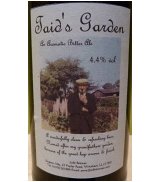 Jolly Brewer Taid's Garden Beside the better known likes of BrewDog, Dark Star and Thornbridge in the first rank of innovative and top quality British microbreweries are a handful of names that, despite limited production and distribution, deserve to be much more widely known and celebrated than they are. One of them is brewster Pene Coles at the Jolly Brewer brewery and brewing supplies shop in the North Wales town of Wrexham: I don’t think I’ve tasted one of her beers that I haven’t enjoyed. Both those below are bottle conditioned.
Cwrw du, which simply means ‘black beer’ in Welsh, is a lovely dark mild, near black in colour with a good, thick head that’s a notably deep shade of mid brown. The smooth and tangy minerally aroma has a touch of roast, while a thick roasty dark malt loaf and vine fruit palate has good cereal and some savoury touches — a salty, smoky tang with perhaps a pinch of oregano. The mellow finish lingers with caramel, liqourice, more malt loaf and subtle roast.
Taid’s Garden is a beautifully refreshing and flowery summer ale with a little inspiration from lager brewing, made with pale and pilsner malts and Goldings, Fuggles and Hallertau hops. It pours a hazy straw colour with a foamy white head. There’s a distinct geranium tinge to an aroma which also yields grass, minerals, honeysuckle and cream. A crisp grassy palate has lemon barley water notes and aromatic hops, reminiscent of elderflower, and the beer dries on the finish to leave deep pepper hop tones and soft lemon on the tongue. It’s named after Pene’s grandfather’s garden, Taid being a dialect word for Grandad.
Read more about these beers at ratebeer.com:
http://www.ratebeer.com/beer/jolly-brewer-cwrw-du/92235/
http://www.ratebeer.com/beer/jolly-brewer-taids-garden/107846/
Beer sellers: Meadow Farm Shop
ABV: 4.5%, 4.8% and 58%
Origin: Tyndyrn, Sir Fynwy, Cymru
Website: www.kingstonebrewery.co.uk
 Kingstone Classic Bitter I tasted several bottle conditioned Kingstone beers during a visit to the adjoining Meadow Farm Shop in the breathtakingly beautiful Wye Valley for a Beers of the World piece in 2008. There’s more background to the brewery in my review of Kingstone Gold, but these beers were also notable either as favourites of the brewery owner or ones that impressed me.
Award winning Classic Bitter is an orange-amber beer with a slightly bubbly off-white head made from pale and crystal malt, hopped with four quite distinctive hop varieties: Northern Brewer, Bramling Cross, Cascade and Willamette. The aroma is fresh and creamy but relatively restrained with citric and malt notes. A dry and tangy palate has cracker-like malt and marmalade, with a slight burnt rubber touch. A note of roasty crystal makes its presence felt on a biscuity dry finish with long lasting peppery hops turning quite earthy and rooty. A decent, well-made bitter with an unusual hop profile.
 Kingstone 1503 Tudor Ale
1503 Tudor Ale commemorates the date of the first manuscript reference to the use of hops in British brewing, as recorded by Richard Arnold. The idea that this old ale closely resembles something Arnold might have brewed is surely fanciful, but 1503 tastes pretty good in its own right, and is certainly old fashioned in inspiration. Brown and smoked malts, used alongside pale and chocolate malts and some malted wheat and oats, recall the darker, smokier malt flavours of centuries past, while the single hop is the old established Fuggles variety. The result is chestnut brown, with a thick fawn head and a roasty burnt toffee and fruit aroma. The palate is dry but slightly treacly, with orange and apple notes, slightly musty yeast flavours, burnt rubber, smoke, lemon squash and caramel notes, but remains light in texture given the vivid flavours. There’s ripe orange on a juicy, slightly nutty and very moreish finish that develops late chocolate hints.
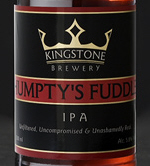 Kingstone Humpty's Fuddle IPA Humpty’s Fuddle, previously known as Humpty Dumpty’s Downfall, is the brewery’s fair enough version of an old-style strong IPA, again hopped only with Fuggles, its pale malt bolstered with crystal malt and maize. This mid-amber beer has a thick and creamy pale fawn head and a yeasty ,malty aroma with a touch of banana. A firm pale malt palate has orange notes, peach syrup and oily spices. There are more orange and spice flavours in the finish which is slightly vinous, distantly reminiscent of Orval, with fennel and peach flavours and a late sprinkling of hops.
Read more about these beers at ratebeer.com:
http://www.ratebeer.com/beer/kingstone-classic-bitter/58236/
http://www.ratebeer.com/beer/kingstone-1503-tudor-ale/79622/
http://www.ratebeer.com/beer/kingstone-humptys-fuddle/104672/
London’s Best Beer, Pubs and Bars updates
Central London – Borough
 The Roebuck, London SE1 4YG Contemporary pub
50 Great Dover Street, SE1 4YG
T (020) 7357 7324
W http://theroebuck.net
Open 1200-2400 (0100 Fri & Sat; 2300 Sun). Children welcome until 2100
Cask beer 3 (Purity, Sambrook’s), Other beer 6 keg (Meantime and imports), 5 bottles
Food Short but imaginative gastro/pub grub menu, Outdoor tables on small public square
Tue quiz, Thu poetry night, big screen sport in separate room, functions, board games
This big former Truman pub right on the historic highway from the Borough to the Kent Coast has benefitted from a makeover of its already favoured wedge shaped site: the junction of Great Dover Street, Trinity Road and Falmouth Road was converted a couple of years back into a small but pleasant public space open only to walkers and cyclists. The pub, owned by the same small independent pubco that also administers the Montpelier in Peckham, still looks fresh and attractive from an arty but comfortable 2003 reinvention: all cream and maroon with iron pillars, an island bar, a mix of seats, retro lampshades, eccentric pictures and a rear lounge dominated by a portrait of Bambi’s mum (actually a doe and not a buck, and portrayed by Disney as a white tailed deer rather than a roe, but never mind).
The cask beer range has stablised on Purity Mad Goose and Pure Ubu and Sambrook’s Wandle, though may occasionally change. Three Meantime keg taps dispense Helles, Wheat and a changing seasonal, while three quality specialist imported lagers — Budvar dark, Stiegl Goldbräu and Schremser Roggen — add to the range alongside Anchor Steam and Sierra Nevada Pale in bottles. The menu has a bigger choice than usual for veggies — celeriac rösti and a three bean stew with polenta and walnut tapenade when I looked — as well as rare breed sausages, burgers, salads and the like. A big upstairs lounge can be booked for private parties, and on Thursdays hosts one of London’s top performance poetry nights, Bang said the gun, billed as “poetry not ponce”. A worthy entry in the outer reaches of London’s beery centre of gravity.
National Rail London Bridge Underground Borough, London Bridge Cycling Links to NCN4, CS5, 7, LCN+ Deptford, Peckham Walking Link to Jubilee Greeway, Thames Path
 Jonathan Williams (left) and James Bull attending Friday night's kiss-in. Pic: BBC For all the undeniable advances of the past few decades, just how comfortable can beer lovers who happen not to be heterosexual really afford to feel when out enjoying a drink in a “straight” pub, even in a big and cosmopolitan city like London? This question has been on my mind over the past few months as I’ve been putting together my forthcoming guidebook to London beer, but the news over the past few days that two gay men had been expelled from a Soho pub for kissing each other has brought it sharply into focus.
I ended up putting two gay pubs in the book (The CAMRA Guide to London’s Best Beer, Pubs and Bars — see under London above) because I was keen to reflect the diversity of London’s pub culture as much as I could as a secondary mission to celebrating good beer. As most LGBT beer fans will know, London’s gay pubs aren’t exactly overflowing with craft beer, but with the help of an old friend I found a couple I was happy with. The last thing I wanted to do was discourage anyone of any sexuality from visiting any of the other places in the book and enjoying the true diversity of London’s beer.
Introducing the first of my “out” choices, I pointed out the dearth of gay pubs serving good beer, and commented: “Perhaps things will change if the development of a more youthful image for good beer continues, or perhaps as attitudes have grown ever more tolerant and people of all sexualities feel more relaxed in mixed company, there’s no need for a fine range of ales to be tagged with a rainbow flag. I hope that lesbian and gay readers, like me, will feel able to enjoy a beer in any place in this book.”
I confess to feeling slightly uncomfortable as I wrote these words. Yes, as a gay man, I do feel able to enjoy a drink in pretty much every decent beer outlet I’ve found in London, and certainly everywhere in the book. But I’m not so sure I’d be happy to express my affection openly to my partner in all of them, in the same way that straight customers do without a thought. A handful of venues spring to mind in the book where I’d be extremely wary of doing this if I wanted a peaceful drink — particularly some places that I admire in all sorts of other ways for being unpretentious, old fashioned local boozers of the sort that are becoming increasingly rare. I contemplated reflecting some of this in the book, but concluded it wasn’t entirely appropriate, especially considering the already lengthy word count. And I could trust most of my LGBT readers to pick up potential issues anyway — we’re all too used to being sensitive and discreet.
Then, the day after I signed off the final text, the news of the John Snow incident emerged to drive home the point. For those who haven’t followed the story, on Wednesday evening (13 April 2011) James Bull and Jonathan Williams, both in their 20s, went out on a first date in Soho. Though in an area full of gay venues, they opted instead to visit the John Snow, a smallish and fairly standard Samuel Smith pub in Broadwick Street, for the sort of reasons that anyone might choose a pub — they liked the cider stocked at Sam’s pubs and appreciated the generally cheap prices. But when the pair started kissing — in a relatively chaste and inoffensive way, according to bystanders — they first attracted complaints from a man drinking at a nearby table who claimed to be the landlord, and were then asked to leave by a female staff member, who accused them of behaving obscenely.
In a fine example of how a small incident affecting hitherto obscure individuals can quickly take on much wider resonance in our socially networked world, the two men’s unpleasant experience became a news story after Jonathan’s disgruntled tweet about it “went viral”, eventually being picked up by the BBC and the Guardian. Prominent gay rights campaigner Peter Tatchell offered his support. On Friday a hastily organised kiss-in at the pub attracted 300 people, and messages of support from a variety of groups including even the Conservative party gay group. Predictably, the pub played safe and closed its doors, so the event took place outside. Another has been called for Thursday.
Journalists’ sympathies for the couple were bolstered when approaches to the pub itself for comment were met with a hostile response, culminating in threats to report people for harassment if they continued to call. The landlord allegedly told one enquirer unapologetically that he could kick people out if he wished. The pub’s owners, fiercely independent and slightly eccentric Yorkshire brewery Samuel Smith, have also refused to comment so far — no surprise to beer writers as they’re well-known for their lack of media friendliness, and are no doubt all at sea in trying to cope with this unwanted attention. Their reaction contrasts with that of pub owning company Punch Taverns, who were involved in a comparable incident last summer when members of a Labour Party LGBT Group were refused service at the Greencoat Boy in Westminster — the pubco quickly apologised.
The legal situation is interesting. Licensees do indeed have the discretion to exclude anyone from their premises, but they musn’t discriminate on the grounds of sexuality in the provision of services. If a case was brought under the Equality Act, the pub would have to prove it treated heterosexual couples in the same way. And while it’s possible staff are equally squeamish about snogging straight couples, it’s rather unlikely.
In some respects this incident seems relatively minor — there are arguably more pernicious forms of discrimination and certainly much more serious outcomes of individual homophobia, such as the brutal murder of Ian Baynham in Trafalgar Square in October 2009. But the way James and Jonathan were apparently treated in the John Snow, and the discomfort I felt when writing the lines quoted above, demonstrate in a very significant and intimate way just how far we still have to go to achieve true equality in our everyday lives.
Expressing affection in public, within reasonable limits, is something that heterosexual people take for granted, and quite rightly, as the affectionate bonds we form with others are at the core of our humanity. For gay men, and others whose relationships don’t conform to the traditional stereotypes, it’s constantly in the back of our minds that such an apparently natural act could provoke hostility and even violence. Seeing this demonstrated in the apparently convivial atmosphere of a pub selling craft beer sadly reminds me that, no matter how much as a gay man I value beer and pubs, I remain an emotional second class citizen in most of them, forever feeling circumspect about things that others are openly able to express. And that’s why we still need places like the two gay pubs listed in my book.
Luckily I didn’t include the Snow in my book, but a couple of other Sam’s places are in there. I hope that James and Jonathan pursue their complaint against Sam’s as far as they can and hopefully exact at least an apology, which may discourage other places from behaving similarly. In the meantime, wouldn’t it be great if some of London’s many other “straight” pubs made a point of welcoming kissing couples of any gender? Particularly the ones that do good beer.
Read more about this story:
http://www.bbc.co.uk/news/uk-england-london-13103647
http://www.guardian.co.uk/uk/2011/apr/15/john-snow-kiss-in-london?INTCMP=SRCH
http://londonist.com/2011/04/gay-couple-removed-from-a-soho-pub-for-kissing.php
http://www.petertatchell.net/lgbt_rights/homophobia/pub-ban-on-gay-kisses-is-illegal-under-equality-laws.htm
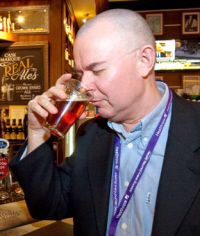 Pic: Gillian Evans. Here’s my Top Tastings list for 2010, a little late thanks to the time dedicated to my forthcoming book (see right or under London above). As in previous years, they’re not necessarily new beers, just beers I happened to taste for the first time, or retaste after a long break, during 2010, and which made me grateful to be involved in such an exciting and satisfying area of human endeavour as beer and brewing. They’re not necessarily the “best” beers I tasted during the year, though all of them scored on the high side for quality, but they’re all rich in interest and character.
As in the past the selection is coloured by my beer drinking itinerary during the year. There’s more than the usual quota of beers from the USA, thanks to my first visit to the Great American Beer Festival, and a welcome first appearance in these lists for Czech beers, thanks in part to my first trip to Prague in a long time. But the rest cover a very varied range, including some truly unusual and impressive British beers that came my way in my capacity as BEER magazine’s Real Ale in a Bottle reviewer.
The 30-strong selection is listed in alphabetical order with no internal ranking implied. Click on the links for detailed tasting notes and background information. Enjoy.
- Avery Maharaja Imperial India Pale Ale 10.5%, Boulder, Colorado, USA
- Beck (Trabelsdorf) Zoigl Kellerbier 5.8%, Trabelsdorf (Lisberg), Franken/Bayern, Germany
- Bernard Sváteční Ležák 5%, Humpolec, Vysočina, Czech Republic
- Blythe Ridware Pale 4.3%, Hamstall Ridware, Staffordshire, England
- Boon Oude Geuze Mariage Parfait 2001 8%, Lembeek, Vlaams-Brabant, Belgium
- Boston Samuel Adams Utopias 2009 27%, Boston, Massachusetts, USA
- Breconshire Ysprid y Ddraig 6.5%, Aberhonddu, Powys, Cymru
- Cigar City Humidor Series India Pale Ale 7.5%, Tampa, Florida, USA
- Dolle Brouwers Stille Nacht Reserva 2005 11.5%, Esen, West-Vlaanderen, Belgium
- Dry Dock Altbier 5.3%, Aurora, Colorado, USA
- Ducato Verdi Black Jack 8.2%, Roncole Verdi, Emilia-Romagna, Italy
- Duck-Rabbit Schwarzbier 5.8%, Farmville, North Carolina, USA
- George Gale Prize Old Ale 2007 9%, Horndean, Hampshire, England
- Green Flash Le Freak 9.2%, Vista, California, USA
- Greene King Strong Suffolk Ale 6%, Bury St Edmunds, Suffolk, England
- Hardknott Granite 10.4%, Millom, Cumbria, England
- Marble Chocolate Marble 5.5%, Manchester, England
- Matuška IPA Raptor 6.2%, Broumy, Středočeský kraj, Czech Republic
- Medvidků Oldgott Barrique 13° 5.2%, Praha, Czech Republic
- Modrá Hvězda Dobřanská Hvězda světly ležak 12° 4.5%, Dobřany, Plzeňský Kraj, Czech Republic
- Molen Hel en Verdoemenis 666 11.5%, Bodegraven, Zuid-Holland, Netherlands
- Moor JJJ IPA 9.5%, Pitney, Somerset, Engand
- Mordue Workie Ticket 4.5%, North Shields, Tyne & Wear, England
- Oud Beersel Oude Lambik 5%, Beersel, Vlaams-Brabant, Vlaanderen
- Port Hop-15 10%, San Marcos, California, USA
- Samuel Smith Yorkshire Stingo 9%, Tadcaster, Yorkshire, England
- SweetWater Dank Tank Magnum IP Imperial Pilsner 9%, Atlanta, Georgia, USA
- Thornbridge Saint Petersburg Highland 2006 7.7%, Ashford-in-the-Water, Derbyshire, England
- Timothy Taylor’s Landlord 4.1%, Keighley, West Yorkshire, England
- Tröegs Troegenator Double Bock 8.2%, Harrisburg, Pennsylvania, USA
 Timothy Taylor Landlord Top Tastings 2010
ABV: 4.1%
Origin: Keighley, West Yorkshire, England
Website: www.timothy-taylor.co.uk
Established in 1858, Timothy Taylor had long enjoyed the respect of discerning beer drinkers as one of the best of the surviving regional independents when in 2003 a certain musician by the name of Madonna Ciccone told TV interviewer Jonathan Ross she regularly enjoyed a pint of its flagship ale Landlord in Soho’s Dog and Duck. This unexpected plug brought still further expansion for a brewery with significant regional, and a building national, presence, though much of it centred on Landlord. Tim Taylor does brew a number of other cask ales which are impressive in their own way, but it’s easy to see why this premium bitter stands out and has won numerous awards, including four Champion Beer of Britain gongs.
Last time I saw an ingredients list, Landlord was made from Scottish Golden Promise pale malt, Fuggles, Styrian Goldings and Whitbread Goldings Variety hops and modest additions of brewing sugar and caramel. It began life as a bottled beer known as Competition Ale in 1952 and migrated to cask in 1953. I’ve based these tasting notes on a cask sample in top nick at the very pleasant Railway Bell pub in Hampton, which only just missed the cut for my forthcoming London’s Best Beer Pubs and Bars book.
Landlord is an orange-amber beer with a fine white head and a notably hoppy, slightly sacky and gingery aroma that turns sweetish with notes of lychees and tropical fruit. A similarly fruity and sacky palate has bitter quinine-like hops balanced by soft fruit flavours. The drying chewy finish is lasting and peppery with biscuity crispness and a firm, slightly worty malt note. Spiked bras and footpath blocking notwithstanding, Ms Ciccone has good taste in beer.
Bottled Landlord, although filtered and pasteurised and some way short of the dazzling qualities of the cask version at its best, is still worth trying. Fecund grassy hops dominate a dry aroma that also has a sweet creamy touch. A distinctive biscuity malt and raspberry juice palate has emerging straw notes and hops, turning instantly hoppy and bitterish on the swallow, with a long finish mixing peppery hops and soft fruit.
Read more about this beer at ratebeer.com: http://www.ratebeer.com/beer/timothy-taylor-landlord-cask/44523/
|
Cask  This pioneering new book explains what makes cask beer so special, and explores its past, present and future. Order now from CAMRA Books. Read more here. This pioneering new book explains what makes cask beer so special, and explores its past, present and future. Order now from CAMRA Books. Read more here.
London’s Best Beer  The fully updated 3rd edition of my essential award-winning guide to London’s vibrant beer scene is available now from CAMRA Books. Read more here. The fully updated 3rd edition of my essential award-winning guide to London’s vibrant beer scene is available now from CAMRA Books. Read more here.
|



















